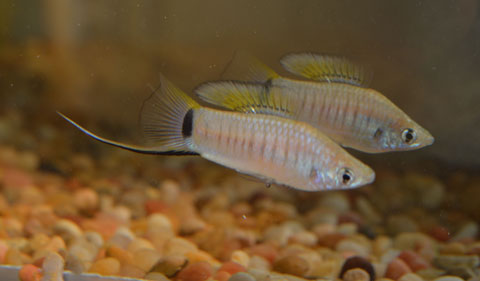
Multilineatus mirror image of swordfish
An article headlined “What makes a pretty face? Animals — including people — are innately drawn to beauty, which may be defined by symmetry or health” in Science News for Students highlights work by Dr. Molly R. Morris and colleagues on female mate preference for symmetry in swordtail fishes.
Morris is Professor of Biological Sciences at Ohio University.
“We all know we shouldn’t judge people based on their looks. Beauty is only skin-deep, as the saying goes. Moreover, someone’s appearance doesn’t tell us anything about how kind they are. Or how dependable. Or anything else about their personality,” writes Alison Pearce Stevens in the article.
But it’s hard to ignore the way a person looks. Something about attractive people makes us want to watch them. We can’t take our eyes off a good-looking actor, actress or model. As such, beauty has power over us. But what is beauty?
There is no simple answer. Researchers have, however, begun probing how beauty affects the behavior of humans and other animals. Through this work, especially, they have discovered some of the features that make an individual attractive to others….
Not just people
Research shows that people with more symmetrical faces don’t just look nice. They also tend to be healthier than asymmetrical people. Genes provide the instructions for how a cell is to perform. All people have the same number of genes. But people with more average faces tend to have a greater diversity in the genes they are born with. And that, research has shown, can lead to a stronger immune system and better health.
Scientists have found similar links between “beauty” and health in other animals too. For example, Molly Morris found that young female swordtail fish prefer symmetrical males. Morris is a behavioral ecologist at Ohio University in Athens. (A behavioral ecologist studies the evolutionary basis of animal behaviors.)
Swordtail fish have dark vertical bars on their sides. Small, young females prefer males with the same number of bars on both sides, Morris says. That love of symmetry matches findings in other species, including zebra finches and lizards, she notes.
But the symmetry rule has some limits — at least in the fish that Morris studies. Larger, older swordtail females prefer asymmetrical males. Morris wondered if this might have to do with how the males had grown. So she and her team tested fish. They fed some males high-quality food and others low-quality food. Certain males grew faster on high-quality food. And those fast-growing males ended up with uneven bars on their sides.
Asymmetry may show that a male has put his energy into rapid growth, Morris says. “In some situations, this can be a good strategy,” she points out. For example, a fish living near lots of predators would be more likely to survive if it grew faster. It would also be better off if it could grow even when food is scarce. So females that live in one of these types of environments should prefer asymmetrical males, Morris explains. Those males would carry the best genes for their environment, and would later pass them on to their young.



















Comments